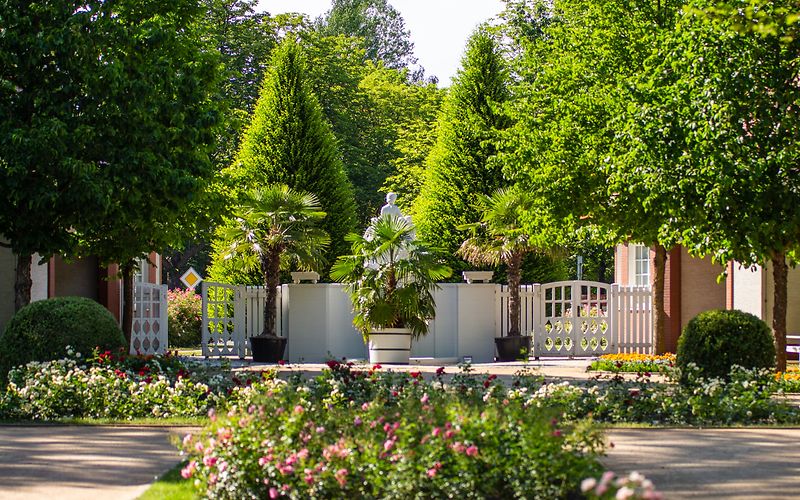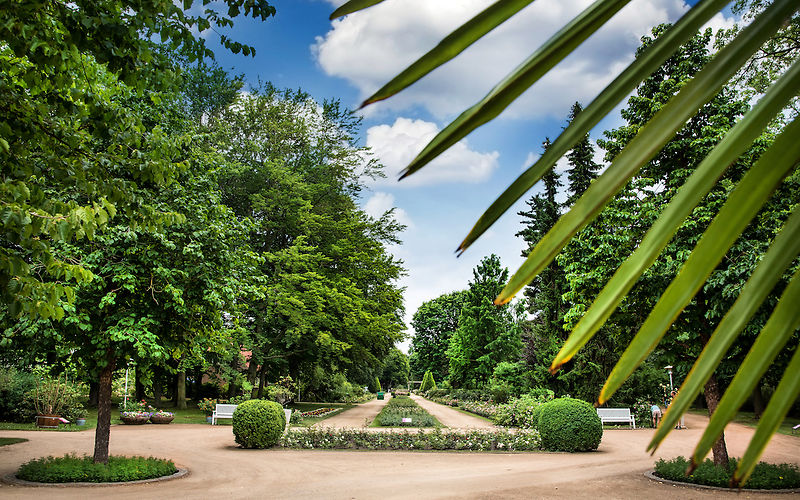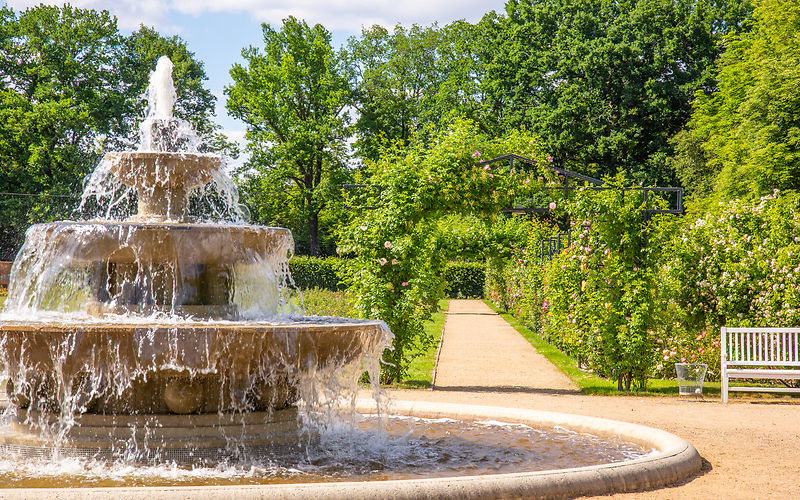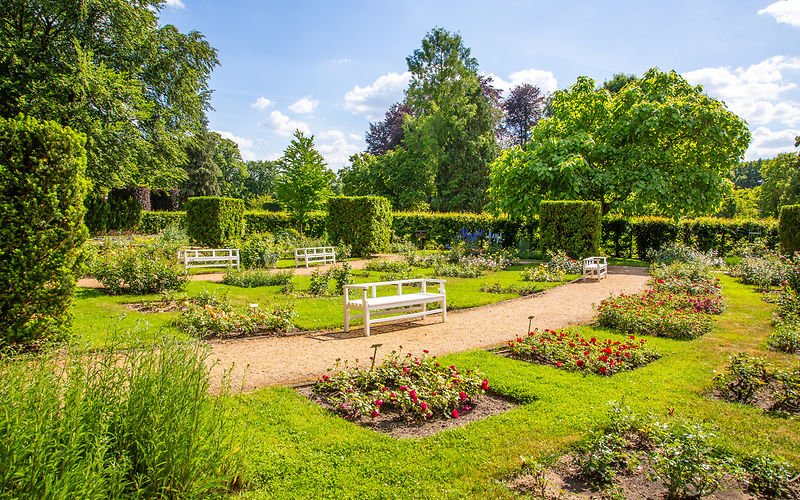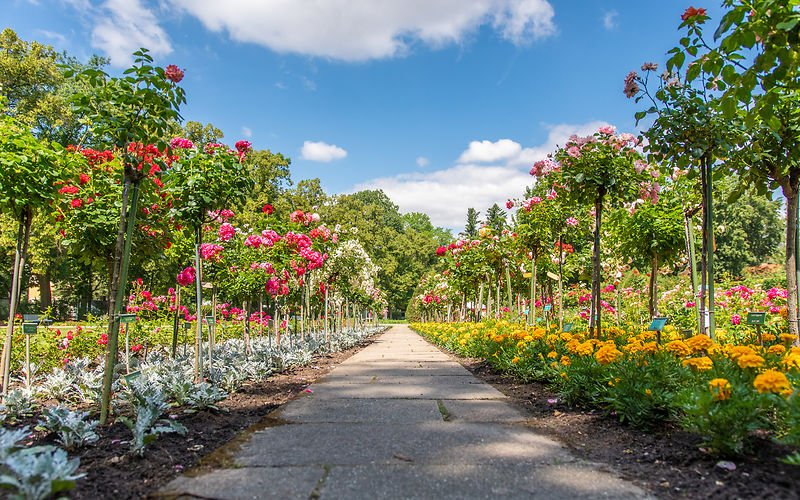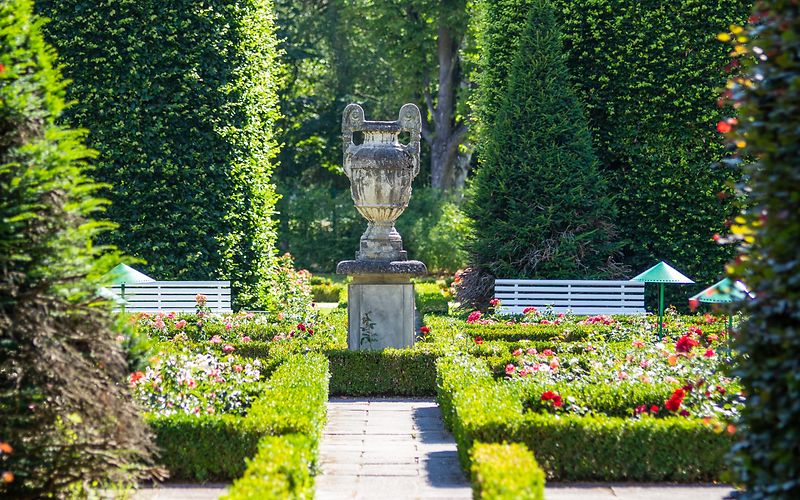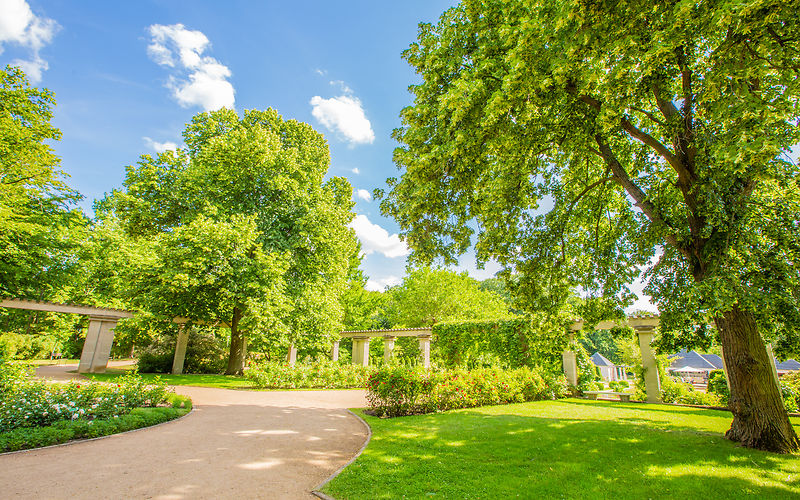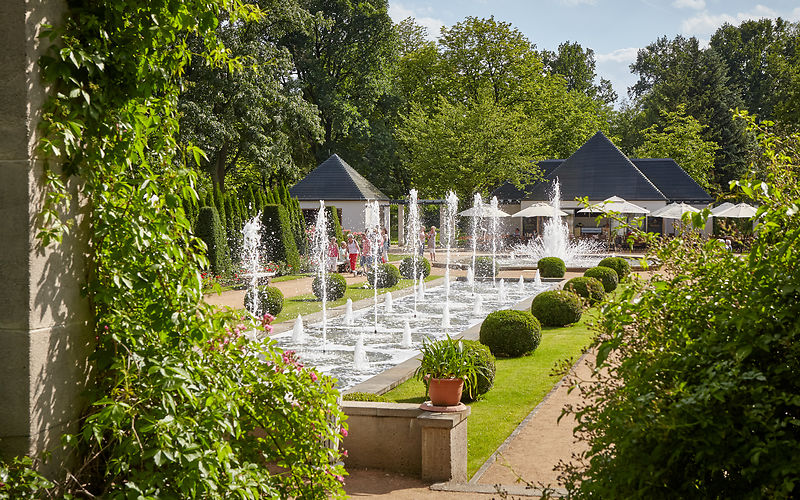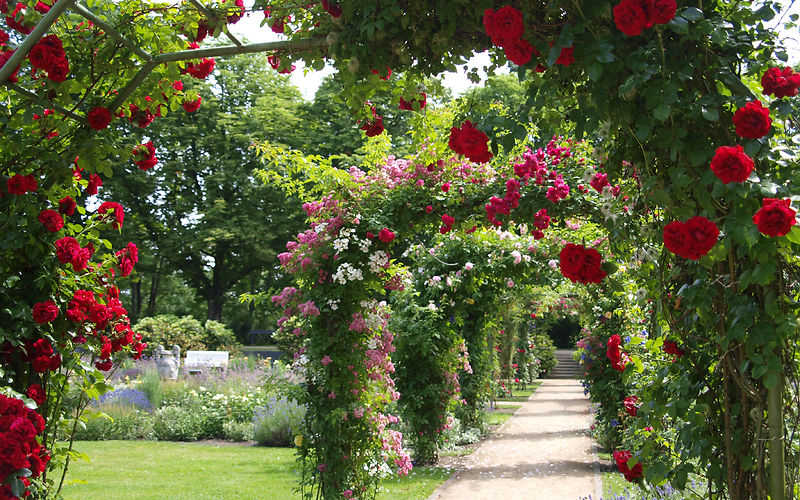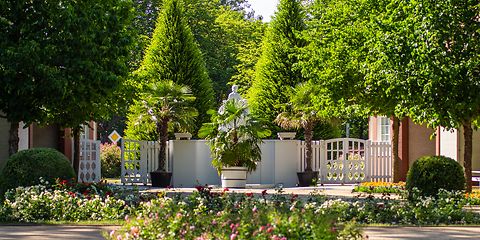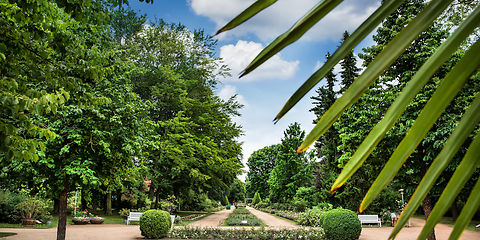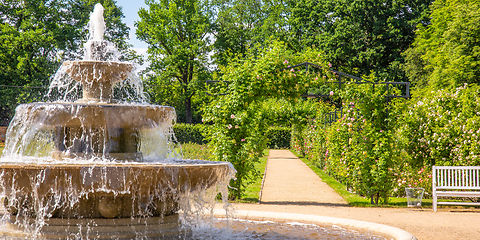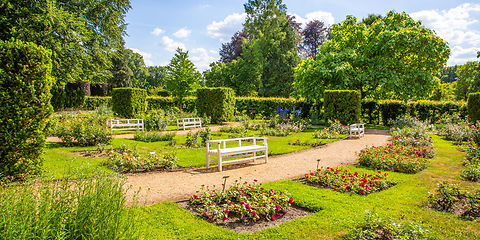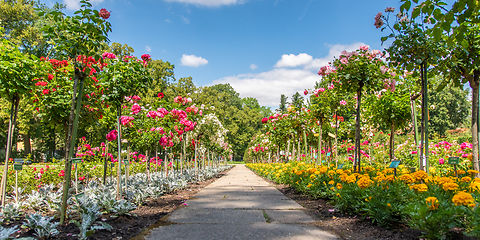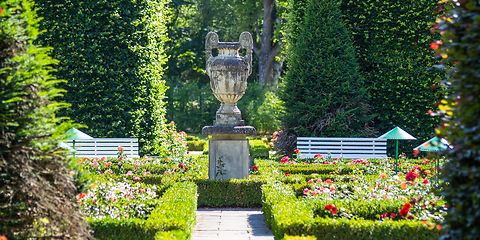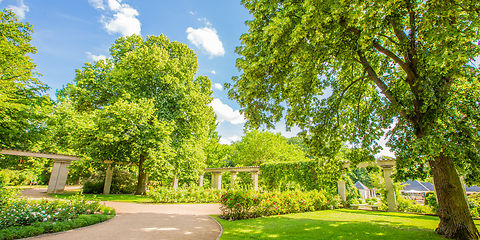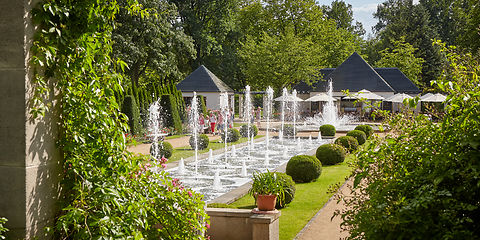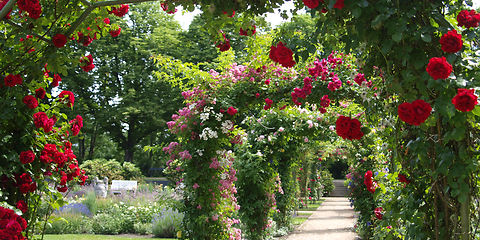Rose Park
Among the creative highlights of the Rose Park area are a number of Art Nouveau elements. Together with themed gardens and romantic water features, they form a framework for the queen of flowers, the rose. Hybrid tea roses, floribunda roses, shrub roses, climbing roses, ground-cover roses and high stem roses are arrayed in splendid variety.
The highlight of the season in the summer months is without doubt the large Novelty Garden with hundreds of new varieties from the best-known German and international rose schools. This part of the park features numerous beautiful fountains and sculptures, such as the Water Fountains and the Cascade Fountain.
Explore the Rose park
We warmly recommend the park guide for those wishing to take in the park’s diverse features and areas under their own steam. It is available at the ticket offices as a brochure, or as an audio guide.
Twenty themed stations installed around the park complex allow visitors to gradually explore the historical site and gain fascinating insights and background information along the way.
Read about the Rose Park at Stations 1–10:

As early as 1913, the historic main entrance was the main entrance from the centre of the industrial town of Forst. Even if the historic ticket offices initially only served as temporary structures for the rose and garden show of one summer, they were characteristic enough to serve as a model for the current buildings when the main entrance area was restored 80 years later.
Bus tour groups usually enter the Rose Park via the historic entrance.
Between the two symmetrical entrance pavilions, guests are greeted by Flora, the goddess of flowers and youth. With her hair tied in a wreath and half-clad in antique style, she holds a cornucopia of flowers in her left hand. Her right hand lies on the shoulder of one of the four Putti who surround her and who are regarded as an allegorical representation of the four seasons.
The sparing decor of the garlanded wall columns with masks as water reservoirs testifies, as does the entire structure, to the artistic spirit and zeitgeist of Art Nouveau.
A wall divides the fountain basin and connects at the same time the two pavilions. In creating this concrete Rose Fountain, the Cottbus sculptor Walter Adler succeeded in combining architecture and art into a unified aesthetic whole.

The main axis with a total length of 200 metres offers a view of the Courtyard colonnade (Peristyle) to the south and the historic main entrance to the north. It unifies several subject areas of the complex and at the same time separates them through artful garden design.
Not far from the main entrance you will find a descendant of the Muskau copper beech. Prince Hermann von Pückler-Muskau planted this prominent old tree by the castle steps in the Bad Muskau Castle Park in 1826. From Count Brühl to Prince Pückler, ceremonial plantings of young saplings from the Muskau copper beech were made in Lusatian parks under the auspices of the European Park Association founded in 2010. This included the East German Rose Garden.
The main axis is bordered by trim hornbeam hedges. Halfway along there are two extraordinary representatives of the rose genus: the so-called green rose and the barbed wire rose. The barbed wire rose is a very unusual and decorative kind of shrub rose because of its early flowers and the cherryred thorns on the new shoots.
The central crossing point of the main axis features an exhibition of German rose towns, villages and districts which includes Forst in Lusatia. In addition to the panels installed for cities and villages selected by the Society of German Rose Friends, numerous rose varieties associated with them are planted here.
The Novelty Garden was created in 1935 as a novelty trial garden in preparation for the Silver Jubilee. In 1938, a further German Rose Show was held in the Rose Garden and was attended by more than 100,000 visitors. By then, experts had come to realise that rose varieties develop differently in different locations.
Today, the Novelty Garden presents more than 250 new rose varieties from different growers in a wide range of shades. The colour-coordinated beet and hybrid tea roses are framed by shrub and climbing roses. The varieties include many new roses from the past ten years, which is why around ten percent of the plant beds in the Novelty Garden are cleared every year for new varieties. As the new rose plants are planted in the same spot, the soil always needs to be replaced as well. Roses that are replaced are used elsewhere in the Rose Garden or in the town area providing they have kept in good condition.
Another piece of history reborn on the 2013 centenary was the impressive cascade fountain. Made of artificial sandstone, the fountain, which in 1913 formed the centre point of the dahlia garden (today the festival meadow of the Wehrinsel Park), was one of the main features of the early gardens. Immediately after the first Rose and Garden Show, the original fountain was moved to the meadow of Count von Brühl’s castle park in nearby Pförten (Brody) in Poland. The remains served as a template for a faithful reconstruction of the fountain.
The relief wall Life on the Oder-Neisse peace border has formed the northern end of the Novelty Garden in the Rose Park since 1967.
The two buildings that close off the Novelty Garden structurally to the west were built between 1956 and 1958 as a residential house and gardener’s accommodation. The latter was extensively renovated prior to the German Rose Show in 2013 and is now available to the park administration as a gardener's cottage.

Just south of the Novelty Garden is the Garden of Award-Winning Beauties. This part of the garden was laid out as a novelty garden on the occasion of the 20th Jubilee in 1933.
During the era of East German era, it was used as a trial garden. A trial in the horticultural sense means the planting of assortments of plants for comparison and evaluation over a specific period of time. The aim is to test the value of a variety for horticultural use. The strictest trial for evaluating assortments of roses is the General German Rose Novelty Test (ADR). In this test, new rose varieties are assessed under different soil and climatic conditions over a period of three years in twelve different trial gardens in Germany. An important criterion in addition to floral properties (such as flowering behaviour, abundance of flowers and fragrance) is leaf health. The use of chemical pesticides is not permitted. Only high-performance and healthy varieties receive the coveted ADR rating at the end of the evaluation period. For rose buyers, this rating is a good guide to which varieties thrive under typical garden conditions.
The Rose Garden has been a trial garden for the ADR since 2012. However, the ADR trial areas are no longer located in the area of the Rose Garden accessible to visitors. As the eastern most extent of the trial gardens, Forst differs from those in northern, southern and western Germany primarily through its more continental climate.
Only varieties that have achieved the coveted ADR rating in recent years are planted in the Garden of Award-Winning Beauties. The colours range from white through to yellow and red to classic pink shades.

A popular form of grafted rose for almost all varieties is the standard rose. It differs visibly from floribunda and hybrid tea roses in the stem of the rootstock, on which a hybrid tea variety is grafted by budding. Nowadays, rose plants of the Rosa canina Pfänder and Rosa canina Pollmeriana varieties are usually used as the rootstock. The Standard Rose Garden has around 300 varieties, including the classic, upright hybrid tea standards.
The memorial stone for garden director Alfred Boese (born 1879) is in the direction of the Teschendorff Garden. He came to Forst as a young landscape architect in 1912 to plan the Rose and Garden Show. As a result, the rose garden became more or less his life's work. He managed the park until his death in 1939 and can therefore be considered the creator of the gardens.
A pavilion donated by a hardware store chain and covered in climbing roses and clematis marks the beginning of the Hybrid Tea Rose Bed to the north. Around 50 of the finest varieties can be found here and beguile visitors with a variety of fragrances at near nose height.
A further element added to the garden in 1953 is the herbaceous border in front of the hornbeam hedge that closes off the Standard Rose Garden and Hybrid Tea Rose Bed to the east. Its floral and decorative effects set a wide variety of creative accents from spring to autumn.
Another special feature awaits the visitor in the Standard Rose Garden. 2007 saw the creation of the first Baby Rose Bed where parents can have a rose planted for their newborns, like a floral birth announcement. Can there be a nicer way of declaring one’s love to one’s offspring.
In the immediate vicinity of the Teschendorff Garden you will find the rose class with the smallest roses in the Rose Garden, the miniature roses. To the left (west) of it are the Spring and Heather Gardens. These were created in 1952 by the then head gardener, Werner Gottschalk. His goal was to provide attractive accents in the garden at different times of year regardless of the rose flowering period.
Numerous early bloomers herald the arrival of early spring with nature’s first glowing colours. Crocuses, scillas and cyclamens as well as flowering shrubs such as the witch hazel lure visitors into the garden. The stone bird bath that can also be found here was one of the classic design elements of the gardens in the 1950s.
The Heather Garden greets visitors with a variety of heather plants, conifers, evergreen shrubs and bog plants – and not only in autumn. An impressive black pine that can be seen here is a contemporary witness to the 1950s.
A memorial stone in the Heather Garden commemorates Paul Engwicht, one of the founding fathers of the Rose and Garden Show in 1913. He was not only engaged in preparing and running the garden show, but also contributed significantly to the preservation of the garden.
Lindenweg, a path leading north, is bordered by a new seasonal planting area of around 1,000 square metres and was created in 2013. Here, according to the seasons, tulips, crown imperials, valerians and alliums herald the spring in a sea of violets, and an array of verbena, sage, bottlebrush, petunias, zinnias and more than 60 different varieties of dahlias show off their colours in summer.

The Teschendorff Garden is the only part of the Rose Garden named after a person. Victor Teschendorff (born Königsberg 2.12.1877, died Dresden 3.10.1960) was one of the leading German rose growers of his time. In 1913, his company was present as one of many exhibitors at the first Rose and Garden Show in Forst. When the East German Rose Garden was threatened with closure less than ten years after its inception, Teschendorff's commitment as major exhibitor to holding a second rose show was one of the deciding factors in the preservation and continued development of the garden. The Rose Show of 7-9 July 1923 took place, in conjunction with the general meeting of the Association of German Rose Friends, under the very difficult conditions of an economic crisis and inflation. Presumably in 1929, on the silver jubilee of his company, the citizens of Forst thanked Victor Teschendorff by naming this part of the garden after him for his great commitment.
The Teschendorff Garden is one of the most architecturally striking parts of the park. It was created in its current strict geometric form in the jubilee year of 1923. The paths were paved with large concrete slabs in the 1930s.
The central and main focal point of the Teschendorff Garden is a wonderfully graceful concrete amphora, a testament to past garden art. Like the Bear Fountain and the Goddess Flora at the main entrance, it was the product of the workshop of Cottbus sculptor Walter Adler. With its antique decorative scenes, it resembles a Greek vase and is testimony to the garden’s foundation period.

In the second half of the 1920s, dykes were built to protect the town of Forst and the East German Rose Garden from the floods of the Neisse. This resulted in changes to the landscape architecture which are most clearly visible in the Peristyle area. Set on a slight elevation, the Peristyle is the destination point of the main axis from the historic main entrance and of the water axis of the Water Fountain. It is also where the path along the chestnut dyke ends. The chestnut trees on the dyke can be dated relatively precisely to the year when the dyke was built in 1927.
The pergolas of the Peristyle borders an open space which is therefore architecturally enclosed. From the Peristyle, unlike any other place in the Rose Garden, you can familiarise yourself within a few steps with the sequence of differently designed garden spaces and clearly see how the garden is situated on a river meadow.
From the 1930s to the 1950s, the courtyard was dominated by tall Lombardy poplars which were planted in a circle in the middle. In the site plan of 1937, the Peristyle was still referred to as Poplar Square. Today the so-called Kordes bed is located here. The roses in this bed all originate from the Kordes company, one of the most renowned German breeders.

One of the highlights of the historic park can be discovered between large, well-shaped cedar hedges: the Big Water Display. It is the centrepiece of the Rose Park and its most impressive water system. A pool was built here in 1913, redesigned several times and finally reconstructed in 2004 according to plans from 1937.
The original octagonal pool, which was filled with water lilies and goldfish, had a high fountain in the middle and fountains at four corners. The edge of the pool was raised a little above the square. Another pool, long and rectangular, was built at ground level and framed right and left along the long sides by roses. Ten fountains in two rows of five were arranged along the sides of the pool. In front of the trimmed cedar hedges that enclosed the Water Display area, rows of pyramid-shaped yew and box trees were arranged between the roses.
Reconstruction of the Water Display after 1963 considerably changed the shape of the pools. The edges of the two pools were raised about 30 cm above the ground and the octagonal pool was made square. In the 1980s, a small footbridge over this pool was very popular with visitors.
In the renovation work of 2004, the basic shapes of 1937 were restored. The Water Display pools have a total surface area of 300 square metres. Switching on the Big Water Display already delighted particularly the younger visitors in the 1930s. In those days, it was operated by inserting a coin; today a push button switch on a steel column activates the Big Water Display.

The Jubilee Garden is one of the themed gardens that has been redesigned several times in the course of the East German Rose Garden’s history, at least in terms of its vegetation. However, the path layout of the 1913 Rose and Garden Show has hardly changed in this area. The wooded area here is a reminder of the involvement of the head gardener of that time in East Germany’s Central Technical Committee on Dendrology and Garden Architecture. The magnolia, the catalpa (Catalpa bignonioides) and the Caucasian wingnut (Pterocarya fraxinifolia) were special trees in those days and no doubt difficult to procure. They could only be obtained through good contacts and professional horticultural exchange. Thanks to Werner Gottschalk's commitment, the Rose Garden is now home to more than 70 different tree and shrub species.
The metal arches supporting the climbing roses that span the paths were erected in the early 1990s.
For the centenary of the Rose Garden in 2013, dahlias were planted for the first time in the current ribbon of flowers along the Lindenweg (the path between the Heather Garden and the historic main entrance). The dahlia garden became the Jubilee Garden for which a more modern form of plant use was chosen. In addition to climbing roses, a few other varieties of roses are sparingly used. The overall surface impression is determined by herbaceous perennials in a play of innumerable nuances of blue and white. So here, the appearance of the garden changes almost every week. The tulips in spring are followed by columbine, sage and catnip; coneflowers and verbena add summer accents after tickseed and lavender; asters and grasses dominate in autumn.



